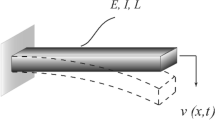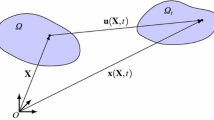Summary
The discretization of vibration problems in structural dynamics by means of fundamental solutions results in a nonlinear representation by so-called lambdamatrices.
Here the dynamic stiffness matrix with transcendental elements is replaced by a linear eigenvalue formulation with static stiffness and a mass matrix. The mass results from interpolating the lambdamatrix either in a Taylor-like or in a Lagrange-like manner.
For the present the essential steps of this procedure are demonstrated for vibrations of beams.
Similar content being viewed by others
References
Providakis, C. P., Beskos, D. E.: Free and forced vibrations of plates by boundary and interior elements. Int. J. Num. Meth. Eng.28, 1977–1994 (1989).
Kitahara, M.: Boundary integral equation methods in eigenvalue problems of elastodynamics and thin plates. Amsterdam: Elsevier 1985.
Beskos, D. E.: Boundary element methods in dynamic analysis. Appl. Mech. Rev.40, 1–23 (1987).
Banerjee, P. K., Ahmad, S., Wang, H. C.: A new BEM formulation for the acoustic eigenfrequency analysis. Int. J. Num. Meth. Eng.26, 1299–1309 (1988).
Wilson, R. B., Miller, N. M., Banerjee, P. K.: Free-vibration analysis of three-dimensional solids by BEM. Int. J. Num. Meth. Eng.29, 1737–1757 (1990).
Brebbia, C. A., Nowak, A. J.: Treatment of domain integrals by using dual and multiple reciprocity methods. In: Discretization methods in structural mechanics (Kuhn, G., Mang, H. eds.) pp. 13–28. IUTAM/IACM SymposiumVienna1989. Berlin-Heidelberg: Springer 1990.
Katsikadelis, J. T., Kandilas, C. B.: A flexibility matrix solution of the vibration problem of plates based on the boundary element method. Acta Mech.83, 51–60 (1990).
Lancaster, P.: Lambda-matrices and vibrating systems. Oxford-London-New York: Pergamon Press 1966.
Leung, A. Y. T.: Multilevel dynamic substructures. Int. J. Num. Meth. Eng.28, 181–191 (1989).
Kolousek, V.: Dynamics in engineering structures. London: Butterworths 1973.
Sotiropoulos, G. H.: Approximate determination of the dynamic stiffness coefficients of beams. Ing.-Arch.47, 319–327 (1978).
Ruge, P.: Optimierung finiter Elemente durch geeignete Ansatz-Generatoren. Ing.-Arch.48, 259–277 (1979).
Spyrakos, C., Chen, C. I.: Power series expansions of dynamic stiffness matrices for tapered bars and shafts. Int. J. Num. Meth. Eng.30, 259–270 (1990).
Clough, R. W., Penzien, J.: Dynamics of structures, pp. 345–363. New York-San Francisco: McGraw-Hill 1975.
De Figueiredo, T. G. B., Brebbia, C. A.: A new variational boundary element model for potential problems. Eng. Anal. with Bound. Elem.8, 45–50 (1991).
Latz, K.,: Power series expansions of frequency dependent boundary formulation (in preparation).
Author information
Authors and Affiliations
Rights and permissions
About this article
Cite this article
Ruge, P. Mass identification from lambdamatrices in structural dynamics. Acta Mechanica 95, 157–166 (1992). https://doi.org/10.1007/BF01170810
Received:
Issue Date:
DOI: https://doi.org/10.1007/BF01170810




